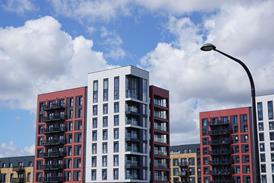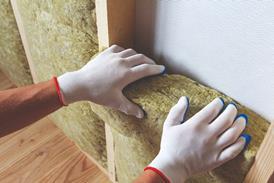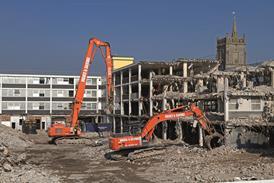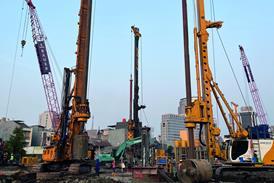This can reduce the maximum internal temperature by 2-3ºC and delay the peak temperature by several hours.
In the simple passive approach, the slab is exposed on the underside (soffit) to allow convective and radiative heat transfer. The key issue is the effectiveness of heat transfer, rather than the quantity of concrete.
However, exposed floor slabs are often rejected on aesthetic grounds – especially when steel decking is used for construction. A possible solution is to use a permeable suspended ceiling that both allows movement of air up to the slab and hides the soffit from view.
The Steel Construction Institute has been working with Oxford Brookes University to examine the thermal effects of different types and layouts of suspended ceiling tile. The research aims to produce guidance on the most effective suspended ceiling configurations for passive fabric energy storage.
About suspended ceilings
Using suspended ceilings in commercial buildings has become widespread in the last several decades because they offer many aesthetic and functional advantages.
The most common mounting system is a suspended grid, into which a variety of ceiling tiles can fit. Grid sizes can vary greatly, although in Europe 600 mm and 750 mm square tiles are popular.
The tiles themselves are usually made of mineral board, fibreboard or steel, and can be plain, perforated or indented with a wide choice of patterns.
Perforated tiles are usually supplied with a sound absorbent backing to improve their acoustic properties. This can be removed easily to produce a tile through which air can flow, while still masking the structural soffit and any service. Example perforation patterns are shown above and overleaf.
Perforations allow air from convective plumes created by people, equipment and sun-heated furnishings to rise through the suspended ceiling and come into contact with the cooler soffit. The air transfers some of its heat to the soffit, where it is conducted into the slab and stored. The cooled air then falls back into the occupied space.
Testing perforated ceilings
The test room for physical measurements formed an insulated box beneath a composite floor slab. It contained a proprietary suspended ceiling grid – into which a variety of ceiling tiles could be fitted – and heat sources of known outputs.
Temperature sensors and a data acquisition system recorded temperatures every ten minutes, enabling the thermal response of the room to be measured precisely.
There were two heat sources, each supplying 55 W/m² to the test room from 08.00 h to 17.00 h – mimicking an office through the working day. The air outside the box was kept at a constant 23ºC.
An axial fan was installed to blow outside air into the test cell from 18.00 h to 08.00 h. It generated 8·7 air changes per hour until the slab temperature fell to 22·3ºC, at which point a relay was triggered.
All tiles were 600 mm square and all but the mineral board tiles were finished in off-white powder coat on the underside, a matt metal finish with some paint overspray above.
Tests on each ceiling type were run over five full days, revealing the cumulative effect of each type over a period of time. The resulting thermal response of the soffit, in terms of calculated dry resultant temperature changes over the test cycle and heat flux densities, are shown in table 1.
Perforated ceilings work
The results show that perforated metal ceilings can still allow significant heat transfer to and from the soffit. They were found to increase the radiative effect, which compensates for the loss in convective heat transfer resulting from the perforations' flow resistance.
An open area of 20% is about the maximum that can be used if a perforated ceiling is to hide the soffit. This allows approximately 40% of the convective heat transfer that would occur with an exposed slab.
However, the thin metal tiles in the ceiling absorb and re-radiate heat from the air into the slab, increasing the radiative component to nearly 50% of the heat flux at the soffit surface.
Under test conditions, over 85% of the cooling effect of an exposed soffit can be obtained with a thin perforated steel ceiling, at the same time as hiding the ceiling void.
The perforated ceiling also forms a radiation shield between a building occupant and the cool soffit, reducing the comfort benefits of a fully exposed slab.
A perforated ceiling may affect an office's acoustic environment, although some engineers think that concerns about acoustics are overstated1.
Nevertheless, the benefits of thermal storage remain. With a slab surface temperature of 21ºC after a period of night cooling, beneficial thermal storage of around 10 W/m² is perfectly feasible using a permeable metal suspended ceiling. This figure approximately equates to the heat output of one person at normal occupation densities. Peak air temperature during the occupied period should also be reduced by 2-3ºC as a result.
Overall then, permeable suspended ceilings, combined with good solar control, a well designed ventilation strategy, good insulation and a tight building envelope, can offer definite advantages.
Perhaps in the future their relative ease of installation, and the fact that no special soffit treatment is necessary, will encourage more widespread uptake of fabric thermal storage in new-build and refurbished office buildings.
Source
Building Sustainable Design



















